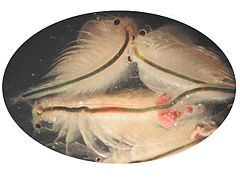Sea-Monkeys

Sea-Monkeys (sometimes Sea Monkeys) is a brand name of a variant (known as Artemia salina nyos or Artemia nyos) of Artemia salina, a species of brine shrimp, a type of fairy shrimp – not true shrimp, but a branchiopod. The term "Sea-Monkeys" is a trademark used to sell them as a novelty pet, often advertised in comic books. Brine shrimp originate in salt lakes and evaporation flats.
Biology
Sea-Monkeys can reproduce both sexually (requiring a male and a female) and asexually. When the eggs are produced, there are fewer males than females, probably because they are not essential for reproduction. Females stop reproducing with the males when the males are too few.[citation needed]
Sea-Monkeys have been cited in studies of DNA and sexual behavior, primarily because they are commonly available specimens.
Sea-Monkeys are a cultivated variety, possibly subspecies, of Artemia salina (brine shrimp), sometimes classified as a new species called Artemia nyos. They were bred for their larger size and longer lifespan, making them more suitable as pets than the original breed of brine shrimp. The U.S. patent 3,673,986 granted in 1972 describes this as "hatching brine shrimp or similar crustaceans in tap water to give the appearance of instantaneous hatching." Advertisements for Sea-Monkeys were widespread in comics in the 1970s, featuring drawings of smiling humanoid creatures that bore little resemblance to brine shrimp.
The key observation that allowed unhatched "Sea-Monkeys" to be cheaply packaged, shipped, and handled is that, in certain easily prepared environments, they enter cryptobiosis, a natural state of suspended animation. When released into their aquarium they leave this state and hatch.
Life cycle
To start the process, the 'water purifier' package is added to water on day one. The user is typically unaware that this package already contains eggs in addition to the salt. At day two, one adds the 'instant life eggs' package, containing Epsom salts, borax and soda ash, in addition to eggs, yeast, and sometimes a blue or green dye. The dye is used to enhance the 'instant life' experience by making the freshly hatched animals more visible. The Sea-Monkeys seen during the second day after adding the 'eggs package' are derived from the eggs added with the 'purifier' package. The food package is a mixture of Spirulina and dried yeast. The 'boost' packages mainly contain salts, which induce sexual activity in artemia.
Sea-Monkeys have a biological life cycle of one year, but thanks to their ability to enter cryptobiosis, the product guarantees that the Sea-Monkeys live for up to 2 years. This should be understood as the colony being able to sustain itself for two years.
Supplies
A number of supplies and accesories can be purchased from the makers of sea-monkeys as well. These include:
Packets
Other than the packets that originally come with the sea-monkeys, a number of packets can be purchased.
Sea Diamonds: This packet contains beads made out of the same substance as the tanks. They begin to rise through the tank as the water level gets lower, hovering in the middle of the tank like landmines. Sea-monkeys will "play" with them, build caves with them, etc. It is recommended by the makers of sea-monkeys that you do not add these until some of the sea-monkeys reach full maturity, otherwise the baby sea-monkeys will not be able to fees properly.
Grow Kwikly: This packet contains a substance that makes sea monkeys grow faster.
Cupid's Arrow: This packet contains substances that induce mating behavior even in cold environments.
Red Magic: This packet contains food that has extra vitamins in it. In addition to improving the health of your sea-monkeys, it gives your sea-monkeys a nice red tinge.
History
Sea Monkeys were first marketed in 1957 by Harold von Braunhut as Instant Life, though Braunhut changed the name to "Sea-Monkeys" on May 10, 1962. Many types of Sea-Monkey kits are now available. The company produces the original Ocean View tank as well as a variety of other products. The Sea-Monkeys company is now part of the Educational Insights corporation, and as of 2005 it is headed by George C. Atamian and son-in-law David Horvitz.
Other companies have distributed pets/toys along the Sea-Monkey model, including one by Wham-O, and "The Swarm", a product from Dr. Jordan's Formulas. In the late 1970s to early 1980s, sachets of "Sea Monsters" sold were sold in 25-cent gumball machines at A&P supermarkets. When added to water, the packet's contents provided the eggs, salt and nutrients to hatch the brine shrimp. More recently “Little Aussie products” (an Australian Company). Has marketed “Itsy Bitsy Sea Dragons”. Notable differences with this kit are that they contain a different brine shrimp species “Parartemia zietziana” and a purple sea snail “Teeny Weeny Winkles”.
A live-action television program based on the comic book advertisements of the 1970s, The Amazing Live Sea Monkeys, was produced in 1992.
As of 2005, there are even slot machines with a Sea-Monkey theme.[1]
In popular culture
A similar fictional product, called "Sea People" was purchased by Eric Cartman in the South Park episode "The Simpsons Already Did It". It didn't take long before Cartman found out they were just brine shrimp, but when he added a bowl of semen to the Sea People container, the brine shrimp mutated into a highly advanced underwater civilization, eventually building statues of Cartman and Tweek after being relocated to an aquarium.
References
This article needs additional citations for verification. (July 2007) |
- "Not From a Sea. Not Monkeys. Discuss." — The New York Times May 15, 2005 (registration required)
- U.S. patent 3,673,986
